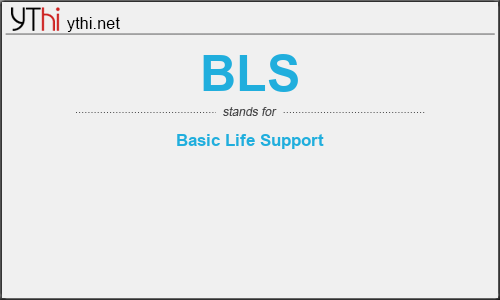What does BLS mean? What is the full form of BLS?
The full form of BLS is Basic Life Support.
Basic Life Support, or BLS, generally refers to the type of care that first-responders, healthcare providers and public safety professionals provide to anyone who is experiencing cardiac arrest, respiratory distress or an obstructed airway. It requires knowledge and skills in cardiopulmonary resuscitation (CPR), using automated external defibrillators (AED) and relieving airway obstructions in patients of every age.
Basic Life Support (BLS) is available in two different training methods – blended learning and classroom training. All BLS course options teach the same AHA science-based skills and result in the same AHA BLS Course Completion Card.
- In addition to the physical skills necessary for providing BLS care to those in need, those working in basic life support also need to have critical-thinking and problem-solving skills, and be able to work as part of a team to deliver the best care possible and improve patient outcomes.
- To learn more about the specific classes that are part of our BLS program, visit the BLS/CPR page. Or, for a deeper dive into what BLS is, you can purchase and review our Basic Life Support Participant’s Manual from the Red Cross Store.
- American Red Cross Basic Life Support classes are developed under the guidance of, and reviewed by, the American Red Cross Scientific Advisory Council. Content in this program is consistent with:
- The International Liaison Committee on Resuscitation (ILCOR) 2015–2018 International Consensus on Cardiopulmonary Resuscitation and Emergency Cardiovascular Care Science with Treatment Recommendations.
- The 2015–2018 American Heart Association Guidelines Update for Cardiopulmonary Resuscitation and Emergency Cardiovascular Care.
- Created with the latest information available, our BLS classes allow you to learn life-saving techniques and can help prepare you for a career in the medical field, as a police officer or firefighter or another career where caring for others is part of the job.
- With the American Red Cross, you can take a variety of in-person and online BLS courses – and get the best of both worlds. When you choose our innovative blended learning program, you’ll not only receive online lecture material, but you’ll also participate in interactive scenarios that allow you to improve your clinical decision-making skills. Once the course is complete, you’ll participate in in-person skills sessions. This way, you can learn at your own pace and hone your skills with an instructor in a group setting.
BLS
means
Basic Life Support![]()
Translate Basic Life Support to other language.
Select another language: Go
Do you want to know What does BLS mean? What is the full form of BLS?. Are you looking for What does BLS mean? What is the full form of BLS? What is BLS stand for? On this page, We talk about the various possible acronym, abbreviation, full form or slang term of BLS. The Full Form of BLS is Basic Life Support
You also might want to know: how to pronounce BLS,
how to pronounce Basic Life Support,
Still can't find the acronym definition for BLS? Please use our site search to look for more acronyms.
Showing the full form of BLS: 'Basic Life Support' on your site.


Leave a Reply
You must be logged in to post a comment.